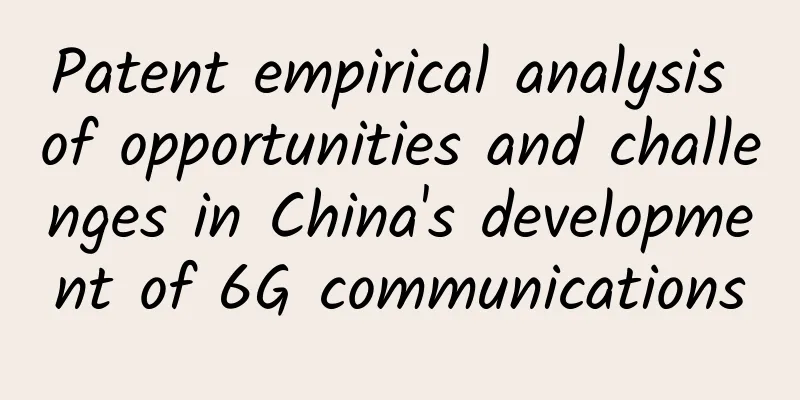Patent empirical analysis of opportunities and challenges in China's development of 6G communications

|
Compared with 2G communication network, 3G realized mobile broadband, but the real role of mobile broadband was not shown until the 4G era. Compared with 4G, 5G communication network emphasizes industrial Internet of Things and the Internet of Everything, but related application scenarios and killer applications are still in the early stages of construction, and the real role may not be shown until the 6G era. The global competition for the new generation of mobile communication technology (6G) has quietly begun.
The goal of mobile communications is to achieve "interconnection and interoperability", which has formed the industry characteristics that the upstream and downstream of the industrial chain must strictly abide by international communication standards. The patent laws of various countries generally stipulate that no unit or individual may implement its patent without the permission of the patent owner, that is, it is not allowed to manufacture, use, promise to sell, sell, or import its patented products for the purpose of production and operation, or use its patented methods and use, promise to sell, sell, or import products directly obtained according to the patented methods. Therefore, once you have an essential standard patent (ESP), you can ban the sale of competitors' products and require them to stop using products that infringe patent rights. This is equivalent to controlling the entrances and exits of highways and toll stations, forming a huge control over the industry, and is bound to be in an important advantageous position in industrial competition. Competing for essential standard patents has become one of the top priorities in the competition of the communications industry. 6G communication standard patent layout enters a critical periodSeizing standard essential patents requires a high timeliness. The internationally accepted patent system has novelty requirements. Simply put, patents must be applied for before the standards are publicly used and published, otherwise the novelty of the patent application will be lost. Therefore, the patent layout for 6G communication standards must be done before the standards are formed. The standardization of 6G network technical specifications will begin in 2023. It is not too early to study and discuss 6G patent issues at present, but time is pressing and time is running out. Looking back at the 5G communication era, my country's communication industry has actively invested in research and development since the early days, and has proposed a series of important technical solutions such as full-duplex and Polar code. Although full-duplex did not enter the 5G communication standard in the end, in our survey of domestic and foreign manufacturers on 6G patents, manufacturers have basically reached a consensus that full-duplex technology will be an important alternative technology for 6G. Five years have passed since the technical vote on the 5G standard. During these five years, there have been trade frictions between China and the United States, and the international competition environment for Chinese ICT manufacturers has deteriorated. Facing the critical period before the formation of the 6G communication standard, it is crucial for the Chinese communications industry to better form alliances in patent layout, form effective synergy and layout to cope with external pressure. In this regard, there is no doubt that scientific research institutes, equipment manufacturers, and operators in the Chinese communications industry pay attention to the overall interests of national and industry development. However, it is very important to grasp the complex technology and patent situation in the technological frontier field such as mobile communications and form a clear working idea. Opportunities and challenges for China's communications industry in 6G patentsHow many 6G patents will there be? IPlytics, a German patent data company, has counted the 5G standard essential patents declared by the European Telecommunications Standards Institute (ETSI). There are currently 21,571 patent families and 95,526 patents in 5G communications, of which 24% have previously declared 4G standard essential patents. According to this ratio, there should be about 5,000 patent families for 5G continuation technologies that are likely to enter the 6G standard. In the 6G patent research conducted by the State Intellectual Property Office, it was also found that Qualcomm's US patent "US10652908B2 A method and device for dynamic priority sorting of delay-sensitive services" on deterministic networks was declared as 3GPP 5G's TS38.321 standard essential patent on March 13, 2020, and this patent is also likely to enter the 6G standard. In the current early stage of 6G technology research, the 6G patent research we have conducted includes about 3.8 patent families for the four major branches of "terahertz", "air-space-sea-ground integration", "deterministic network" and "AI air interface". As major telecommunications companies compete with each other and choose clear paths, the number of patents involved in the formation of specific standards may be smaller than this number. By analyzing the big data of 38,000 patent families involved in 6G communications, it can be found that the majority of them are patent applications filed after 2011. Correspondingly, the patents included in 4G were mainly applied for after 1997. However, my country's independent innovation in patents in the communications industry started late, and it was not until 1997 that the first mobile communications patent was applied for, which was the TD-SCDMA standard essential patent CN97104039.7 applied for by Mr. Li Shihe of Xinwei Communications. 6G mainly relies on patent applications filed after 2010, which provides objective and powerful conditions for my country's independent innovation to seize the commanding heights of 6G. The annual trend of the number of 6G patent applications in the world and China is shown in Figure 1. Figure 1 Annual trends in the number of 6G patent applications in the world and China From the development trend of 6G patents, the number of US patents ranked first from 2001 to 2009, and the number of applications from China, Europe, Japan and South Korea was not much different. After 2009, the number of applications from China began to increase rapidly, significantly exceeding that of the United States, Europe, Japan and South Korea. At the same time, China is also the main target country in the field of 6G key technologies, followed by the United States and Japan. my country should step up its tracking and catching up with foreign countries’ 6G technologies, which have technological advantages. For example, in terms of high-altitude platform communication technology, China started late in battery and related antenna technology, and only started applying for patents in 2015. In terms of link management, the relevant patent applications of foreign applicants involve the management and control of different link modes, and patent applications continue to appear, while domestic patent applications in this area have received less attention. In terms of deterministic network technology, European and American companies have a long history of technological innovation and rich patent reserves. However, China is currently still in the stage of joint research and development of "industry, academia and research", and its independent intellectual property creation and reserves in deterministic network technology are relatively weak. It is recommended that domestic innovation entities pay more attention to the development trends of international advantageous technologies, conduct corresponding research and development, and shift from pursuing quantity to improving quality in patent layout, promote breakthroughs in key core technologies, and support the high-quality development of patents. A prominent phenomenon in the current 6G technology research and development in my country is that colleges and universities and scientific research institutions occupy the top ten patent applications for China's 6G key technologies. From the ranking of the number of applications by Chinese patent applicants, it can be seen that the top ten applicants include 8 applicants from colleges and universities, 2 applicants from scientific research institutes, and no applicants from enterprises. According to statistics from the Ministry of Education, the implementation and transformation of patents in Chinese universities needs to be strengthened. The patent conversion rate of Chinese universities is generally lower than 10%, while the patent conversion rate of high-level universities in the United States is about 40%. There is a large gap between the patent conversion of Chinese universities and high-level universities abroad. Integrating the domestic "industry-university-research" advantageous resources to promote patent transformation is an important topic for independent innovation of 6G patents. Patent risks of 6G key technology deterministic networkHigh-reliability, low-latency deterministic network technology is mature and widely used, which is one of the most important demands of the industry for 6G communication. From the perspective of network evolution trend, with the development of 5G to B market services, mobile communication networks are gradually transforming from serving consumer Internet to serving industrial Internet, and are gradually becoming the technical foundation of industrial Internet and Internet of Vehicles. The further integration of ICT and OT has prompted mobile communication networks to evolve from providing "best effort" rigid pipelines to providing "deterministic" on-demand customized network services. Time-sensitive services place extreme demands on network performance. With the development of industrial manufacturing, Internet of Vehicles, and smart grid services, mobile communication networks need to support deterministic service transmission while supporting ultra-low latency. However, China's deterministic network technology started later than Europe and the United States, and the number of patent applications in China is about half of that in the United States. Data equipment manufacturers in the United States and Europe (such as Cisco, Intel, etc.) and large manufacturing companies (such as General Electric, Siemens, Airbus, etc.) have a large number of patent applications. Cisco in the United States has declared standard essential patents in IETF; with the continuous integration of information technology and operational technology, Ethernet and mobile communication network technologies are constantly cross-border integration, and deterministic network technology has begun to enter the 3GPP 5G R16 and R17 standards. Well-known mobile device manufacturers (such as Qualcomm, Nokia, Ericsson, Huawei, Samsung, Intel, etc.) have all begun patent layout. At present, there are 9 essential patents for time-sensitive network technology declared in ETSI. I believe that with the development of the industrial Internet, more standard essential patents will be declared. |
<<: Why does TCP need three handshakes and four waves?
>>: Ericsson signs 5G SA agreement with Spanish telecom operator Masmovil
Recommend
How will the epidemic affect the development of 5G in China? Will China's 5G fall behind again?
[[313809]] During the 2020 Spring Festival, the &...
IPv4 history ends, IPv6 era officially arrives
1. What’s coming has finally come—IPv4 address ex...
2G quietly withdraws from the network, 4G grows steadily, and it is still a bit far to talk about 5G now
The withdrawal of 2G/3G networks is not a new top...
Is it OK to leave the router on for a long time? Is there any harm if I don't turn it off?
Some people say that WIFI is the vitamin of the I...
The SD-WAN track has changed. When will the dragon trainer appear?
In an environment where cloud computing, mobile a...
From 300 million to 600 million, what challenges does 5G user growth still face?
[[419577]] It has been two years since the 5G lic...
Hard-core dry goods: HTTP timeout, repeated requests must see the pitfalls and solutions
[[351757]] 1 Timeout, unavoidable pain HTTP call ...
Co-construction and sharing to protect and release the dividends of 5G
[[351365]] There has always been controversy in t...
RAKsmart cluster server starts from $177.52/month, 5+253 IPs, San Jose/Los Angeles/Japan/Hong Kong data centers available
We have shared information about RAKsmart cloud s...
CloudCone: CDN promotion starts at $4.5/year, including nodes in Hong Kong/Taiwan/Vietnam/Japan/USA
In March this year, the blog shared the informati...
What will happen when 5G network falls in love with public cloud?
[[410935]] Recently, AT&T, the second largest...
Codebeamer: Next-generation ALM product, driving digital innovation in the manufacturing industry
The Internet of Everything, cloud computing, and ...
Application of modular power distribution system in high-density data center
Traditional data center power distribution archit...
CDN enters the licensing era, and the Ministry of Industry and Information Technology regulates and cleans up the CDN market
On December 12, the Ministry of Industry and Info...
US reportedly allows chip sales to Huawei but only for non-5G business
Things have been bad for Huawei since the US ban....

![[Black Friday] ITLDC: 40% off unlimited traffic VPS annual payment, 25% off dedicated server, 14 data centers in the United States/Singapore/Netherlands](/upload/images/67cabff1c82b9.webp)







